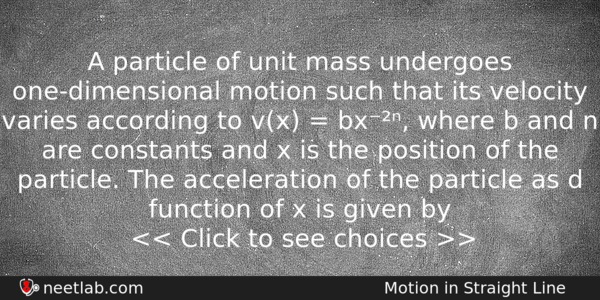| ⇦ | 
| ⇨ |
A particle of unit mass undergoes one-dimensional motion such that its velocity varies according to v(x) = bx⁻²ⁿ, where b and n are constants and x is the position of the particle. The acceleration of the particle as d function of x is given by
Options
(a) -2nb²x⁻⁴ⁿ⁻¹
(b) -2nb²x⁻²ⁿ⁺¹
(c) -2nb²e⁻⁴ⁿ⁺¹
(d) -2nb²x⁻²ⁿ⁻¹
Correct Answer:
-2nb²x⁻⁴ⁿ⁻¹
Explanation:
No explanation available. Be the first to write the explanation for this question by commenting below.
Related Questions: - A charged particle (charge q) is moving in a circle of radius R with uniform speed v
- Magnetism of a magnet is due to
- A thin circular ring of mass M and radius R rotates about an axis through its centre
- If the half-life of a material is 10 yr, then in what time, it becomes 1/4th part
- One-fourth length of a spring of force constant K is cut away. The force constant
Topics: Motion in Straight Line
(93)
Subject: Physics
(2479)
Important MCQs Based on Medical Entrance Examinations To Improve Your NEET Score
- A charged particle (charge q) is moving in a circle of radius R with uniform speed v
- Magnetism of a magnet is due to
- A thin circular ring of mass M and radius R rotates about an axis through its centre
- If the half-life of a material is 10 yr, then in what time, it becomes 1/4th part
- One-fourth length of a spring of force constant K is cut away. The force constant
Topics: Motion in Straight Line (93)
Subject: Physics (2479)
Important MCQs Based on Medical Entrance Examinations To Improve Your NEET Score
18000+ students are using NEETLab to improve their score. What about you?
Solve Previous Year MCQs, Mock Tests, Topicwise Practice Tests, Identify Weak Topics, Formula Flash cards and much more is available in NEETLab Android App to improve your NEET score.
Share this page with your friends

Leave a Reply